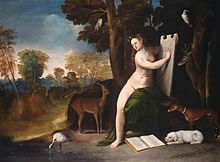Dosso Dossi
Dosso Dossi | |
|---|---|
Ercole II d'Este, Duke of Ferrara |
Giovanni di Niccolò de Luteri, better known as Dosso Dossi (c. 1489–1542),[1] was an Italian Renaissance painter who belonged to the School of Ferrara, painting in a style mainly influenced by Venetian painting, in particular Giorgione and early Titian.[2]
From 1514 to his death he was court artist to the
Biography
Dossi was born in
Dosso Dossi is known less for his naturalism or attention to design, and more for cryptic allegorical conceits in paintings around mythological themes, a favored subject for the humanist Ferrarese court (see also
The painting Aeneas in the Elysian Fields was part of the Camerino d'Alabastro of Alfonso I in the Este Castle, decorated with canvases depicting bacchanalia and erotic subjects including Feast of the Gods by Giovanni Bellini and Venus Worship by Titian. The frieze paintings were based on the Aeneid; this scene by Dossi is book 6, lines 635–709, wherein Aeneas is guided over the bridge into the Elysian Fields by the Cumaean Sibyl. Orpheus with the lyre flits in the forest; in the background are the ghostly horses of dead warriors.
In Hercules and the Pygmies, Hercules has fallen asleep after defeating Antaeus, and is set upon by an army of thumb-size pygmies, whom he defeats. He gathers them in his lion skin. Paintings depicting a powerful Hercules were commonly made for the then-ruler Duke Ercole II d'Este. The subjects of the Mythological Scene and Tubalcain are unknown.

Recently, "Portrait of a Youth" at the National Gallery of Victoria, has been identified by the museum as a portrait of Lucrezia Borgia by Dosso Dossi, having previously been regarded as the portrait of an unknown young male by an unknown painter.[4]
In Ferrara, among his pupils were
Selected works



at the National Gallery of Art, Washington, D.C.
- Holy Family with Donors (1514, Philadelphia Museum of Art)
- Aeneas in the Elysian Fields, (1518–1521, National Gallery of Canada, Ottawa)
- The Virgin Appearing to Sts John the Baptist and John the Evangelist (1520s, Uffizi Gallery, Florence)[6]
- Jupiter painting Butterflies, Mercury and the Virtue, (1524, Wawel Castle, Kraków)
- Mythological Scene, c.1524; oil on canvas, 164 × 145 cm, J. Paul Getty Museum, Los Angeles[7]
- Allegory of Music, (1530s, Museo Horne, Florence)
- Allegory of Fortune, c.1530; oil on canvas, 178 × 216.5 cm, J. Paul Getty Museum, Los Angeles[8]
- Portrait of a Woman, 1530–1535; oil on canvas, Musée Condé
- Virgin of the Assumption and St. Michael the Archangel, c.1533–34, Galleria nazionale di Parma
- Three Ages of Man or Rustic Idyll; 77.5 × 11.8 cm, Metropolitan Museum of Art
- Aeneas, Barber Institute, Birmingham
- Hercules and the Pygmies Alte Galerie of the Joanneum Graz
- Tubalcain (Allegory of Music) Museo Horne
- Witchraft Stregoneria (Choice of Hercules between Vice and Virtue) Galleria degli Uffizi
- Saint Michael (Staatliche Kunstsammlungen, Dresden)
- Saint George and the Dragon (Staatliche Kunstsammlungen, Dresden)
- Portrait of a Warrior, Uffizi Gallery, Florence
- Portrait of a Youth, portrait of Lucrezia Borgia, National Gallery of Victoria[9][10]
- The stoning of Saint Stephen, Thyssen-Bornemisza Museum, Madrid, on loan to the MNAC Barcelona.[11]
Notes
- ^ From: Battista Dossi
- ^ Hartt, 617
- ^ Hartt, 617
- ^ "NGV's Renaissance mystery woman revealed". Brisbane Times.
- ^ *Hobbes, James R. (1849). Picture collector's manual adapted to the professional man, and the amateur. London: T&W Boone. p. 77.
- ^ Web Gallery of Art. The Virgin Appearing to Sts John the Baptist and John the Evangelist. Retrieved September 23, 2008.
- ^ J. Paul Getty Museum. Mythological Scene. Archived 2010-07-18 at the Wayback Machine Retrieved September 23, 2008.
- ^ J. Paul Getty Museum. Allegory of Fortune. Archived 2007-05-30 at the Wayback Machine Retrieved September 23, 2008.
- ^ Infamous Renaissance woman subject of mystery portrait – Australian Broadcasting Corporation 26 November 2008, retrieved on 26 November 2008.
- ^ Gallery unveils portrait of infamy – The Sydney Morning Herald, 26 November 2008, retrieved on 26 November 2008.
- ^ "The Stoning of Saint Stephen". Museo Nacional Thyssen-Bornemisza. Retrieved 2019-09-24.
References
- ISBN 0500235104
- Gibbons, Felton (1968). Dosso and Battista Dossi; court painters at Ferrara. Princeton, NJ: Princeton University Press.
- J. Carter Brown (1986). National Gallery of Art (ed.). The Age of Correggio and the Carracci: Emilian Painting of the 16th and 17th Centuries (First ed.). Cambridge University Press. pp. 111–128. ISBN 978-0521340199.
- Freedberg, Sydney J. (1993). Pelican History of Art (ed.). Painting in Italy, 1500–1600. pp. 315–322 Penguin Books Ltd.
- Ciammitti, Luisa; Ostrow, Steven F.; Settis, Salvatore (1998). Dosso's fate: painting and court culture in Renaissance Italy. Los Angeles: ISBN 0-89236-505-6.
External links
- Dosso Dossi: Court Painter in Renaissance Ferrara, a full text exhibition catalog from The Metropolitan Museum of Art
- Short biography and pictures at the J. Paul Getty Museum
- Images of some paintings
- Gallery at MuseumSyndicate Archived 2010-09-13 at the Wayback Machine
- Works by Dosso Dossi at Census of Ferrarese Paintings and Drawings
